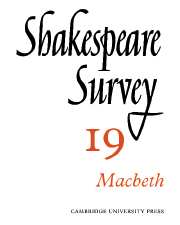Book contents
- Frontmatter
- ‘Macbeth’ in the Twentieth Century
- The Criminal as Tragic Hero: Dramatic Methods
- Antithesis in ‘Macbeth’
- Why was Duncan’s Blood Golden?
- Image and Symbol in ‘Macbeth’
- ‘Macbeth’ and The Furies
- Hell-Castle and its Door-Keeper
- ‘His Fiend-Like Queen’
- The Fiend-Like Queen: A Note on ‘Macbeth’ and Seneca’s ‘Medea
- Shakespeare at Street Level
- New Findings with Regard to the 1624 Protection List
- Shakespeare Productions in the United Kingdom: 1965
- The Royal Shakespeare Company 1965
- The Year's Contributions to Shakespearian Study: 1 Critical Studies
- 2 Shakespeare’s Life, Times and Stage
- 3 Textual Studies
- Index
- Plate Section
Antithesis in ‘Macbeth’
Published online by Cambridge University Press: 28 March 2007
- Frontmatter
- ‘Macbeth’ in the Twentieth Century
- The Criminal as Tragic Hero: Dramatic Methods
- Antithesis in ‘Macbeth’
- Why was Duncan’s Blood Golden?
- Image and Symbol in ‘Macbeth’
- ‘Macbeth’ and The Furies
- Hell-Castle and its Door-Keeper
- ‘His Fiend-Like Queen’
- The Fiend-Like Queen: A Note on ‘Macbeth’ and Seneca’s ‘Medea
- Shakespeare at Street Level
- New Findings with Regard to the 1624 Protection List
- Shakespeare Productions in the United Kingdom: 1965
- The Royal Shakespeare Company 1965
- The Year's Contributions to Shakespearian Study: 1 Critical Studies
- 2 Shakespeare’s Life, Times and Stage
- 3 Textual Studies
- Index
- Plate Section
Summary
In the Introduction to the revised Arden edition of Macbeth (1951) Kenneth Muir notes as ‘one of the predominant characteristics of the general style of the play’ the fact that ‘it consists of multitudinous antitheses’. He connects ‘this trick of style with the “wrestling of destruction with creation” which Mr Wilson Knight has found in the play, and with the opposition he has pointed out between night and day, life and death, grace and evil’. Muir also refers to Mgr Kolbe, who sees the play as picturing ‘a special battle in a universal war’, the war between sin and grace, with a ‘two-fold contrast . . . —Darkness and Light, as a parable, Discord and Concord as a result’. What I wish to say in the present essay is related to the general conception of antithesis: and, more particularly, it is related to the themes identified and analysed by L. C. Knights in How Many Children Had Lady Macbeth? (1933). Knights states that ‘Two main themes, which can only be separated for the purpose of analysis, are blended in the play—the themes of the reversal of values and of unnatural disorder. And closely related to each is a third theme, that of the deceitful appearance, and consequent doubt, uncertainty and confusion.’ Some of the passages to which I shall refer are discussed by Knights.
- Type
- Chapter
- Information
- Shakespeare Survey , pp. 25 - 33Publisher: Cambridge University PressPrint publication year: 1967

